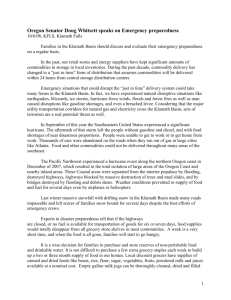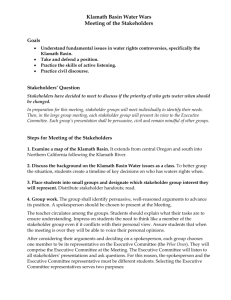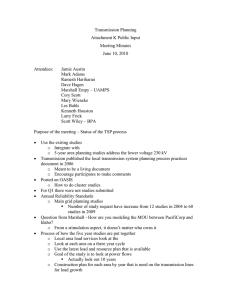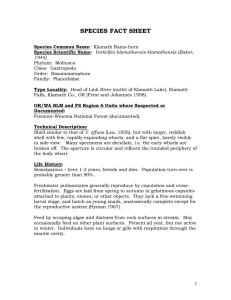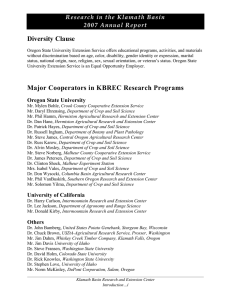Wheat and Barley Variety Screening in the Klamath Basin, 2007
advertisement
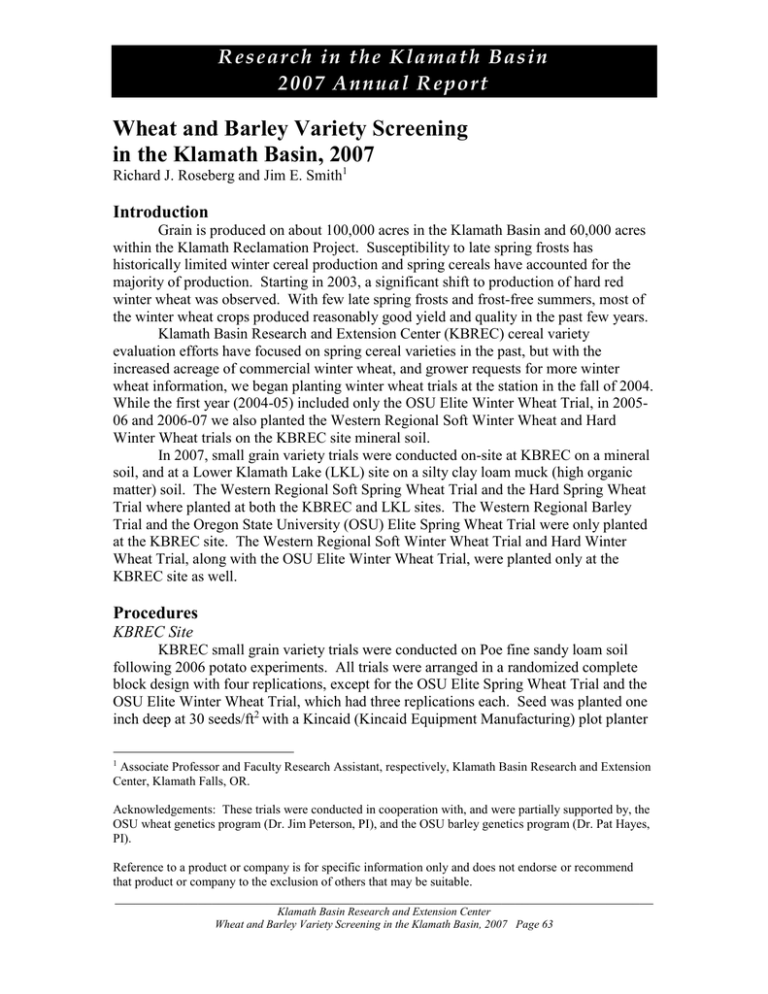
Research in the Klamath Basin 20 07 Annual Report Wheat and Barley Variety Screening in the Klamath Basin, 2007 Richard J. Roseberg and Jim E. Smith1 Introduction Grain is produced on about 100,000 acres in the Klamath Basin and 60,000 acres within the Klamath Reclamation Project. Susceptibility to late spring frosts has historically limited winter cereal production and spring cereals have accounted for the majority of production. Starting in 2003, a significant shift to production of hard red winter wheat was observed. With few late spring frosts and frost-free summers, most of the winter wheat crops produced reasonably good yield and quality in the past few years. Klamath Basin Research and Extension Center (KBREC) cereal variety evaluation efforts have focused on spring cereal varieties in the past, but with the increased acreage of commercial winter wheat, and grower requests for more winter wheat information, we began planting winter wheat trials at the station in the fall of 2004. While the first year (2004-05) included only the OSU Elite Winter Wheat Trial, in 200506 and 2006-07 we also planted the Western Regional Soft Winter Wheat and Hard Winter Wheat trials on the KBREC site mineral soil. In 2007, small grain variety trials were conducted on-site at KBREC on a mineral soil, and at a Lower Klamath Lake (LKL) site on a silty clay loam muck (high organic matter) soil. The Western Regional Soft Spring Wheat Trial and the Hard Spring Wheat Trial where planted at both the KBREC and LKL sites. The Western Regional Barley Trial and the Oregon State University (OSU) Elite Spring Wheat Trial were only planted at the KBREC site. The Western Regional Soft Winter Wheat Trial and Hard Winter Wheat Trial, along with the OSU Elite Winter Wheat Trial, were planted only at the KBREC site as well. Procedures KBREC Site KBREC small grain variety trials were conducted on Poe fine sandy loam soil following 2006 potato experiments. All trials were arranged in a randomized complete block design with four replications, except for the OSU Elite Spring Wheat Trial and the OSU Elite Winter Wheat Trial, which had three replications each. Seed was planted one inch deep at 30 seeds/ft2 with a Kincaid (Kincaid Equipment Manufacturing) plot planter 1 Associate Professor and Faculty Research Assistant, respectively, Klamath Basin Research and Extension Center, Klamath Falls, OR. Acknowledgements: These trials were conducted in cooperation with, and were partially supported by, the OSU wheat genetics program (Dr. Jim Peterson, PI), and the OSU barley genetics program (Dr. Pat Hayes, PI). Reference to a product or company is for specific information only and does not endorse or recommend that product or company to the exclusion of others that may be suitable. ______________________________________________________________________________ Klamath Basin Research and Extension Center Wheat and Barley Variety Screening in the Klamath Basin, 2007 Page 63 Research in the Klamath Basin 20 07 Annual Report on October 3, 2006 for the winter wheat trials, and on April 20, 2007 for the spring trials. The plots were 20 by 4.5 ft, (9 rows at 6-inch spacing), with a harvested area of 14.5 by 4.5 ft. All winter and spring grain plots were fertilized with 50 lb/acre N, 63 lb/acre P2O5, and 41 lb/acre S banded at planting (applying 16-20-0-13 fertilizer at 310 lb/acre). On April 16, the winter wheat trial area was treated with Weedar® 64 (2,4-D amine, Nufarm Americas Inc.) herbicide at 1.5 pint/ac (0.7 lb ae/ac) tank-mixed with Solution 32 to apply 50 lb N/ac using a conventional ground sprayer. An additional 60 lb/acre N was applied to the winter wheat area as Solution 32 on May 24 through the irrigation water. In the spring grain trial area, we applied a tank-mix of Weedar® 64 (2,4-D amine, Nufarm Americas Inc.) at 2.0 pint/ac (0.9 lb ae/ac) and Solution 32 to apply 50 lb N/ac on May 24 using a conventional ground sprayer. Solid-set sprinklers arranged in a 40- by 40-ft pattern were used for irrigation. Crop water use estimates from the KBREC Agricultural Meteorological (AgriMet) weather station were used to apply irrigation to meet crop needs. The spring barley trial area received a total of 12.6 inches of irrigation during the season, applied on 15 occasions. The spring wheat trial area received a total of 16.9 inches of irrigation during the season, applied on 20 occasions. The winter wheat trial area received a total of 7.7 inches of irrigation during the season, applied on 7 occasions. In addition to irrigation, rainfall totaled 0.73 inch in April, 0.24 inch in May, 0.44 inch in June, 0.57 inch in July, and 0.18 inch in August. Plots were harvested using a Hege (Hans-Ulrich Hege) plot harvester with a 4.5-ft-wide header. The OSU Elite Winter Wheat Trial and the Western Regional Hard Winter Wheat Trial were harvested on August 24. The Western Regional Soft Winter Wheat Trial was harvested on August 29. The four spring barley and wheat variety trials were harvested on September 6 & 7. LKL Site LKL spring grain variety trials were conducted on Algoma silt loam soil in a continuous grain rotation. The field was flooded during the winter to replenish moisture to the entire soil profile. Both trials were arranged in a randomized complete block design with four replications. Seed was planted with a Kincaid plot planter as was done at the KBREC site (above) on May 14, 2007. All plots were fertilized with 50 lb/acre N shanked in before planting as anhydrous ammonia, followed by 50 lb/acre N, 63 lb/acre P2O5, and 41 lb/acre S banded at planting (applying 16-20-0-13 fertilizer at 310 lb/acre). The plots were irrigated by the grower during the season with the overhead linear move system used for the entire field (several hundred acres), based on his judgment of water need. Plots were harvested on September 21 with a Hege plot harvester as was done at the KBREC site. KBREC and LKL Sites Due to personnel issues at KBREC, grain harvested from all plots was shipped to the OSU wheat breeding program in Corvallis for cleaning and analysis in 2007, except for the barley trial, which was cleaned and analyzed at KBREC. Unfortunately, the two trials grown at the LKL site (Western Regional Soft Spring Wheat Trial and the Western ______________________________________________________________________________ Klamath Basin Research and Extension Center Wheat and Barley Variety Screening in the Klamath Basin, 2007 Page 64 Research in the Klamath Basin 20 07 Annual Report Regional Hard Spring Wheat Trial) were accidentally discarded by student employees in Corvallis before seed cleaning; therefore yield calculation was not possible. For the trials grown at the KBREC site, grain yield and test weight were measured for all trials except the two Western Regional Winter Wheat trials, where only seed yield was measured. For the spring barley trial, percent plumps (percent above 6/64 and 5.5/64 sieves) and thins (pan) were measured in addition to seed yield and test weight. Lodging percentage was minimal in all trials in 2007. Plant height and maturity (date of 50 percent heading) were not recorded. All measured parameters were analyzed statistically using SAS® for Windows, Release 9.1 (SAS Institute, Inc.) software. Treatment significance was based on the F test at the P=0.05 level. If this analysis indicated significant treatment effects, least significant difference (LSD) values were calculated based on the student’s t test at the 5 percent level. Results and Discussion Soil moisture was good during seedbed preparation, and resulting germination and stand density were good. There was good availability of irrigation water, lack of frost, and relatively few hot days during the season. However, weed control was slightly less than ideal, probably due to use of 2,4-D only. These factors contributed to fair yields in 2007. By comparing yields of check varieties over the years, we observed several trends, including: spring barleys generally yielded better in 2007 than 2006; spring wheats generally yielded less in 2007 than in 2006, and winter wheats were mixed, some were better in 2006, some in 2007. In most cases for all small grain trials, yields were greater in 2005 than either 2006 or 2007. More details and year-to-year comparisons are described below. Western Regional Spring Barley Variety Trial Forty entries were included in the 2007 trial, planted at the KBREC site only. This trial included 17 feed entries (varieties or selections), 15 malting entries, and 8 entries that could be used for either feed or malting. Yields ranged from 3,780 to 6,040 lb/ac with a mean of 5,020 lb/ac (Table 1). These yields were slightly higher than those observed in the comparable 2006 trial. Bushel (bu) weights were greater than the 48 lb/bu industry standard for all entries, indicating good moisture, fertility, and weather conditions during the seed-filling phase. Only two of the entries had bushel weights below 50 lb/bu. While the overall mean bushel weight in 2007 was the same as in 2006, the percent of seed retained on the 6/64 screen (the plumpest seed) was greater in 2007, in excess of 98% for all entries. Multiple-year yield means for all entries that were planted in the 2005, 2006, and 2007 trials at KBREC were calculated (Table 2). Twelve entries were planted all three years, including five named varieties and seven numbered entries. For these twelve entries, overall mean yields were greatest in 2005, followed by 2007, with 2006 yields the lowest. However, some individual entries did not follow this pattern. The yields of 01Ab10062, 02WNZ-1821, and UT99B1670-3458 were greater in 2006 than in 2007. The yield of Morex was greater in 2007 than either 2005 or 2006. ______________________________________________________________________________ Klamath Basin Research and Extension Center Wheat and Barley Variety Screening in the Klamath Basin, 2007 Page 65 Research in the Klamath Basin 20 07 Annual Report Individually, feed types Steptoe and Baronesse continued to perform well over time, with both finishing among the top three in yield for both the 2-year and 3-year means. Among numbered entries, the malting type 99NZ102 did very well, finishing second in yield over the 3-year mean, and fourth for the 2-year mean. Western Regional Soft Spring Wheat Variety Trial Four standard named varieties and seven numbered selections were included in both the KBREC and LKL trials in 2006. All were soft white spring types. At the KBREC site, yields ranged from 4,826 to 5,685 lb/acre, with a mean of 5,292 lb/acre (Table 3). Yield differences were not statistically significant at the P=0.05 level. As in 2006, Alturas was among the highest yielding entries. Unlike 2006, Nick and Louise had among the lowest yields in 2007. Differences in bushel weight were statistically significant. Overall bushel weights in 2007 were lower than in 2006 or 2005, with a mean of 59.9 lb/bu. Top entries included Alpowa, ID0669, ID0630, IDO668, and Alturas. As in 2006, Alturas, IDO630 and IDO669 had very good combinations of yield and bushel weight. Multiple-year yield means for all soft white spring wheat entries that were planted in the 2005-2007 trials at KBREC were calculated (Table 4). As noted above, 2005 was a good year for small grains, and the 2005 yield was greater than either the 2006 or 2007 yields for all six entries that were planted all three years. Of the nine entries that were planted in both 2006 and 2007, most had a higher yield in 2006. Alturas continued to do well over time, with both the greatest two-year and three-year yield. Western Regional Hard Spring Wheat Variety Trial This trial evaluated five hard white spring (HWS) and ten hard red spring (HRS) wheat experimental lines and named varieties at both the KBREC and LKL sites. Differences in yield were statistically significant at the P=0.05 level. Total yields at the KBREC site ranged from 3,392 to 5,646 lb/acre, with a mean of 4,786 lb/acre (Table 5). HRS and HWS varieties were both represented among the highest- and lowest-yielding entries. Overall yields were somewhat lower than in 2006, but were not far below the long-term average, as described above. Differences in bushel weight were statistically significant. The overall mean bushel weight was equal to the 60.0 lb/bu industry standard, but were lower than those observed in 2006, when mean bushel weight was very high (63.3 lb/bu). Of the entries planted in 2005, 2006, and 2007, only IDO377S was among the highest in bushel weight all three years (2nd highest in 2005, and tied for 3rd in 2006, and 4th in 2007). The five highest bushel weights were HRS varieties in 2007, nearly the opposite trend observed in 2006. In the multiple-year rankings, only four entries were grown in all three years (Table 8). IDO377S had the second-highest mean yield for the three years. In previous reports, we noted that IDO377S had the highest three-year mean yield for previous threeyear comparisons (2002-2004, 2003-2005 and 2004-2006). This consistently excellent performance is worth noting, especially since it was not the highest yielding variety in any of the individual years. ______________________________________________________________________________ Klamath Basin Research and Extension Center Wheat and Barley Variety Screening in the Klamath Basin, 2007 Page 66 Research in the Klamath Basin 20 07 Annual Report OSU Elite Spring Wheat Variety Trial Thirty entries were planted in this trial at the KBREC site only, including 16 named varieties and 14 experimental lines. Yields ranged from 3,594 to 5,772 lb/acre, with a mean of 4,650 lb/acre (Table 7). Yields were somewhat lower overall in 2007 than a similar trial in 2006. Yield and bushel weight differences between varieties were both statistically significant. Bushel weights ranged from 57.1 to 61.1 lb/bu, with a mean of 59.6 lb/bu. The lowest value was equal to that observed in 2006, but the trial mean and highest values were higher than observed in 2006. Western Regional Soft Winter Wheat Variety Trial Thirty-five entries, including four named varieties and 31 experimental lines, were planted in the trial at the KBREC site only. Differences between varieties were statistically significant for yield. Bushel weight was not measured by staff in Corvallis. Yields ranged from 963 to 5,469 lb/acre, with a mean of 3,194 lb/acre (Table 8). Yields for this trial were lower in 2007 than 2006, possibly due to the trial location having a surprisingly large quackgrass infestation. Unlike 2006, when the decades-old ‘Stephens’ variety had the highest yield, in 2007 the only named variety in the top half of entries was Brundage96, which had the sixth highest yield. Western Regional Hard Winter Wheat Variety Trial The Western Regional Hard Winter Wheat Trial was planted at the KBREC site only. Unlike 2006, when this trial had only three entries, in 2007 this trial had 26 entries, including three named varieties and 23 experimental lines. Yields ranged from 574 to 5,372 lb/acre, with a mean of 3,742 lb/acre (Table 9). Not surprisingly with the dramatically increased number of entries, both the lowest and highest yields were more extreme in 2007 compared to 2006. Bushel weight was not measured by staff in Corvallis. Yield differences between varieties were statistically significant. Mean yield of this trial was slightly higher than the mean of the Western Regional Soft Winter Wheat Trial. Comparing results with the prior year, the yield of Finley was slightly higher in 2007, but the yields of Boundary and Kharkof were quite a bit lower in 2007 than 2006. OSU Elite Winter Wheat Variety Trial After an absence of an elite winter wheat trial for many years here, we began planting Dr. Jim Peterson’s OSU Elite Winter Wheat Trial in 2004-05 due to growers’ increased interest in winter wheat information. We repeated this trial in 2005-06 and 2006-07 using Dr. Peterson’s updated entry list. Thirty-seven entries, including 16 named varieties and 21 experimental lines, were planted in the trial at the KBREC site only. Of these, four entries were club types and 33 were soft white types. Yield and bushel weight differences between varieties were both statistically significant. Yields ranged from 2,826 to 5,886 lb/acre, with a mean of 4,098 lb/care (Table 10). These yields were somewhat higher in 2007 compared to this trial in 2006. It is interesting that ORSS-1757 and ORH010085 had the lowest and third-lowest yields in 2007, whereas they were among the top yields in 2006. As was ______________________________________________________________________________ Klamath Basin Research and Extension Center Wheat and Barley Variety Screening in the Klamath Basin, 2007 Page 67 Research in the Klamath Basin 20 07 Annual Report true in 2006, all bushel weights were below the industry standard of 60 lb/bu in 2007. They ranged from 52.9 to 58.5 lb/bu, with a mean of 55.7 lb/bu. Bushel weights overall were lower than the previous year. This continues a trend where bushel weights of winter wheats tend to be lower than spring wheats in KBREC trials. Using data from the 2004-05, 2005-06, and 2007 OSU Elite Winter Wheat trials, as well as the 2005-06 and 2006-07 Western Regional trials, we can compare multipleyear yield means for 38 named and experimental winter wheat varieties (Table 11). As noted previously, yields were higher in 2005 than for the other two years. For entries that were planted all three years, yields were higher in 2007 for some, but were higher in 2006 for others. Of the 16 named varieties, eight had greater yields in 2006 than in 2007. Of the 18 entries that were in the trials for the past three years, only Brundage96 (1st) and Stephens (5th) were among the top third in 3-year mean yield. Summary The Western Regional Spring Barley and OSU Elite Winter Wheat trials produced generally higher yields in 2007 than in 2006, the Western Regional Hard Winter Wheat Trial was somewhat similar between years, and the remaining trials produced generally lower yields in 2007 than in 2006. Even so, the yields in 2007 were only slightly below the long-term trial average for this location. It is clear that unexpected growth of quackgrass in the winter trial area contributed to reduced yields in some cases. Unfortunately, due to the accidental loss of data from the LKL site, we cannot compare the results between locations for the Western Regional Soft Spring Wheat and the Western Regional Hard Spring Wheat trials. Crop rotation has some influence on the results of these trials and with grain production in the Klamath Basin in general. Spring grains can easily follow potatoes grown the previous year, benefiting from typical potato management such as high rates of fertilization and common use of fumigants, which also reduce weed seeds. Even where spring grain follows grain the year before, spring moisture, tillage, and use of grain herbicides often results in good stands with low weed pressure levels. Winter grains, however, generally follow either a shorter season crop such as grain or canola, or at times it can follow a forage crop such as alfalfa. To follow alfalfa, however, generally means not taking a final cutting in September, spraying the alfalfa with herbicide, extensive tillage, or some combination of the three, all during a time of year when irrigation water may be less available, which can make tillage more difficult and timely germination more problematic. With these rotations, the potential for weed infestation is also greater than following potatoes where fumigants or herbicides are used, or following grain where additional time between crops can be used in tillage, herbicide application, or both to reduce weed pressure. Therefore, except where rotations and low weed pressures make it feasible, it is often easier and more economical to simply grow spring grains in rotation with potatoes or spring grains, rather than trying to prepare and grow fall-planted grains. ______________________________________________________________________________ Klamath Basin Research and Extension Center Wheat and Barley Variety Screening in the Klamath Basin, 2007 Page 68 Research in the Klamath Basin 20 07 Annual Report Table 1. 2007 Western Regional Spring Barley Nursery, planted in mineral soil (ranked by yield). Klamath Basin Research and Extension Center, Klamath Falls,OR. Variety Row Use 02WA-7052.9 Steptoe Baronesse 01AB11107 UT99B1669-3243 BZ504-129 02WA-7018.13 99NZ102 02WNZ-1015 01NZ706 BZ503-097 01NZ392 PB1-04-2R-4262 02WNZ-1100 Harrington PB1-04-2R-4038 Stander 2ND22182 2B99-2766-10 MT020204 MT030042 2B99-2771-1 ND20299 ND20448 2ND22927 BZ502-265 2B99-2771-9 2B99-2316-4 MT010158 ND21306 MT010160 Morex PB1-04-2R-4257 01Ab10062 02WNZ-1821 01Ab10055 UT99B1670-3458 PB1-04-2R-4057 MT020155 2ND21867 2 row feed 6 row 2 row 2-Row 6 row 2 row 2 row 6 row 2 row 6 row 2 row 6 row 2 row 2 row 2 row 2 row 6 row 2 row 2 row 2 row 2 row 2 row 6 row 6 row 2 row 2 row 2 row 2 row 2 row 6 row 2 row 6 row 2 row 2 row 2 row 2 row 6 row 2 row 2 row 2 row feed feed feed feed feed feed feed/malting feed feed/malting feed feed/malting feed feed malting feed malting malting malting feed/malting feed/malting malting malting malting malting feed malting malting feed/malting malting feed/malting malting feed malting feed malting feed feed feed/malting malting Mean LSD (0.05) CV (%) P value Yield lb/ac BuWt lb/bu 6040 5790 5790 5630 5570 5540 5540 5520 5490 5450 5410 5380 5350 5300 5260 5250 5190 5170 5150 5130 5130 5080 5050 5000 4920 4860 4850 4820 4690 4680 4630 4620 4460 4270 4270 4250 4220 4150 4140 3780 52.4 50.2 50.6 52.9 52.3 52.5 53.1 49.7 52.2 50.6 52.8 52.0 54.3 53.2 53.8 54.7 53.4 54.6 52.2 52.5 54.1 52.2 53.0 52.1 53.7 52.2 51.4 52.7 53.2 54.8 52.8 51.6 53.3 52.4 50.4 52.4 49.2 52.3 50.3 52.5 5020 NSD 19.3 0.210 52.5 1.6 2.1 <0.001 6/64 % 5.5/64 % Pan % 99.1 99.5 99.3 99.1 99.4 99.3 99.4 99.0 99.1 99.3 99.3 99.4 99.4 99.0 98.7 98.6 98.9 99.4 98.9 99.0 99.2 98.9 99.1 99.3 99.0 99.1 98.7 98.8 98.9 99.5 98.8 99.5 99.2 98.8 99.0 98.9 98.9 99.4 98.7 99.0 0.5 0.3 0.5 0.6 0.4 0.4 0.4 0.7 0.6 0.5 0.4 0.4 0.4 0.7 0.8 0.8 0.7 0.3 0.7 0.6 0.5 0.7 0.6 0.5 0.5 0.6 0.7 0.7 0.8 0.4 0.8 0.4 0.4 0.7 0.7 0.7 0.8 0.4 0.9 0.5 0.3 0.2 0.2 0.3 0.2 0.2 0.2 0.3 0.3 0.2 0.3 0.2 0.3 0.3 0.4 0.6 0.4 0.3 0.4 0.3 0.3 0.4 0.3 0.3 0.5 0.4 0.5 0.5 0.3 0.2 0.4 0.1 0.3 0.5 0.3 0.5 0.3 0.2 0.4 0.4 99.1 0.6 0.4 0.006 0.6 0.4 45.2 0.005 0.3 0.2 43.1 0.001 ______________________________________________________________________________ Klamath Basin Research and Extension Center Wheat and Barley Variety Screening in the Klamath Basin, 2007 Page 69 Research in the Klamath Basin 20 07 Annual Report Table 2. Three-year yield summary, Western Regional Spring Barley Nursery, planted in mineral soil. Klamath Basin Research and Extension Center, Klamath Falls, OR, 2005-2007 (ranked by 2-year mean yield). Yield Variety Row 2005 2-yr mean 2006 2007 Yield 3-yr mean Rank lb/acre Malting Varieties Yield Rank lb/acre 99NZ102 6 6430 4850 5520 5185 4 5600 2 01NZ706 6 5620 4910 5450 5180 5 5327 7 2B99-2771-1 2 6790 4710 5080 4895 7 5527 4 Stander 6 6240 4570 5190 4880 8 5333 6 01NZ392 6 5790 4370 5380 4875 9 5180 9 2B99-2316 2 6310 4560 4820 4690 10 5230 8 Harrington 2 2 5690 4010 5260 4635 12 4987 10 4640 4270 4455 13 6 2 4470 3800 4620 4210 15 4297 12 3830 4250 4040 16 Steptoe 6 6100 5780 5790 5785 1 5890 1 Baronesse 2 2 5920 5060 5790 5425 2 5590 3 5030 5490 5260 3 5960 4570 5570 5070 6 5367 5 02WNZ-1821 6 2 5060 4270 4665 11 UT99B1670-3458 6 5630 4570 4220 4395 14 4807 11 5913 4645 5061 4853 01Ab10062 Morex 01Ab10055 Feed Varieties 02WNZ-1015 UT99B1669-3243 Mean 5261 ______________________________________________________________________________ Klamath Basin Research and Extension Center Wheat and Barley Variety Screening in the Klamath Basin, 2007 Page 70 Research in the Klamath Basin 20 07 Annual Report Table 3. 2007 Western Regional Soft Spring Wheat Nursery, planted in mineral soil (ranked by yield). Klamath Basin Research and Extension Center, Klamath Falls, OR. Variety Type Yield lb/acre Bu Wt lb/bu ID0669 Alturas ID0668 ID0630 ID0644 ID0671 WA008008 Louise Alpowa Nick ID0642 SWS SWS SWS SWS SWS SWS SWS SWS SWS SWS SWS 5685 5620 5559 5402 5391 5375 5282 5116 5022 4939 4826 60.7 60.0 60.2 60.4 58.6 60.0 59.8 59.9 61.5 59.6 58.6 5292 1016 12.8 59.9 0.7 1.5 Mean LSD (0.05) CV (%) 1 SWS = soft white spring. ______________________________________________________________________________ Klamath Basin Research and Extension Center Wheat and Barley Variety Screening in the Klamath Basin, 2007 Page 71 Research in the Klamath Basin 20 07 Annual Report Table 4. Three-year yield summary, Western Regional Soft Spring Wheat Nursery, planted in mineral soil. Klamath Basin Research & Extension Center, Klamath Falls,OR, 2005-2007 (ranked by two year mean yield) Variety Type1 2005 Yield 2006 2007 2-yr mean Yield Rank lb/acre Alturas SWS IDO669 SWS Louise SWS Nick SWS IDO668 lb/acre 6800 5620 6210 1 5920 5680 5800 2 8180 6220 5120 5670 7700 6260 4940 SWS 5340 IDO644 SWS Alpowa SWS IDO642 IDO630 Mean 1 8630 3-yr mean Yield Rank 7017 1 3 6507 3 5600 4 6300 4 5560 5450 5 5370 5390 5380 6 9770 5650 5020 5335 7 6813 2 SWS 6290 5770 4830 5300 8 5630 6 SWS 7490 5070 5400 5235 9 5987 5 8010 5822 5284 5553 6376 SWS = soft white spring; SWC = soft white club. ______________________________________________________________________________ Klamath Basin Research and Extension Center Wheat and Barley Variety Screening in the Klamath Basin, 2007 Page 72 Research in the Klamath Basin 20 07 Annual Report Table 5. 2007 Western Regional Hard Spring Wheat Nursery, planted in mineral soils (ranked by yield). Klamath Basin Research and Extension Center, Klamath Falls, Oregon. Variety Type Yield lb/acre UC1552 OR4201262 UC1551 ID0667 UC1495 Clear White ID0665 ID0377S Hank OR4031111 OR4201261 OR4201219 UC1554 UC1419 UC1553 HRS HWS HRS HRS HRS HWS HRS HRS HRS HRS HWS HRS HWS HWS HRS 5646 5331 5287 5232 5164 5088 5049 5038 5034 4991 4595 4269 4069 3602 3392 61.4 60.4 61.2 61.2 60.5 59.0 59.7 60.6 60.1 59.0 59.7 58.8 59.9 58.6 59.9 4786 525 15.0 60.0 0.7 1.6 Mean LSD (0.05) CV (%) 1 Bu Wt lb/bu HRS = hard red spring; HWS = hard white spring. ______________________________________________________________________________ Klamath Basin Research and Extension Center Wheat and Barley Variety Screening in the Klamath Basin, 2007 Page 73 Research in the Klamath Basin 20 07 Annual Report Table 6. Three-year yield summary, Western Regional Hard Spring Wheat Nursery, planted in mineral soil. Klamath Basin Research and Extension Center, Klamath Falls,OR, 2005-2007 (ranked by two year mean yield) Yield Variety Type1 2005 2006 2-yr mean 2007 Yield 3-yr mean Rank lb/acre IDO377S IDO665 CLEAR WHITE HANK OR4201262 OR4201261 OR4201219 UC1419 Mean 1 HRS HRS HWS HRS HWS HWS HRS HWS 6930 Rank lb/acre 5630 6570 6110 5920 5920 5450 6130 6050 5920 5040 5050 5090 5030 5330 4600 4270 3600 5805 5580 5505 5475 5390 5365 5160 4760 6488 6009 4751 5380 5690 7700 Yield 1 2 3 4 5 6 7 8 6180 2 5567 6217 3 1 5050 4 5753 HRS = hard red spring; HWS = hard white spring. ______________________________________________________________________________ Klamath Basin Research and Extension Center Wheat and Barley Variety Screening in the Klamath Basin, 2007 Page 74 Research in the Klamath Basin 20 07 Annual Report Table 7. 2007 OSU Elite Spring Wheat Nursery, planted in mineral soil (ranked by yield). Klamath Basin Research and Extension Center, Klamath Falls, Oregon. Variety Type Yield lb/acre Bu Wt lb/bu Cataldo WA008008 Louise BZ903445WP 37C-3 77-154-98 Merrill Nick IDO377S* BZ604-008 Lolo OR4990144 OR4031111 Tara 2002 Jefferson* Alpowa* Hank Winchester Sagittario OR4201019 ACS52610 Alturas Cabernet Vaiolet Goetze RS150076R OR4201261 OR4201104 OR4201219 Blanca Grande SWS SWS SWS HWS HWS SWS SWS SWS HWS SWS HWS HRS HRS HRS HRS SWS HRS HRS HRS HRS HRS SWS HRS HWS SWW HRS HWS HWS HRS HWS 5772 5676 5352 5268 5244 5214 5208 5202 5130 5058 4956 4866 4728 4710 4704 4626 4572 4506 4458 4398 4362 4320 4158 4104 4074 3996 3960 3822 3726 3594 60.1 59.8 60.1 58.8 61.1 58.5 59.6 59.7 60.5 60.5 60.5 59.7 59.1 60.4 60.1 59.9 59.5 60.5 59.6 60.7 62.4 60.1 58.3 57.4 57.7 57.1 58.7 60.0 59.6 58.9 4650 660 8.7 59.6 0.9 0.9 Mean LSD (0.05) CV (%) 1 HRS = hard red spring; HWS = hard white spring; SWS = soft white spring; SWW = soft white winter. ______________________________________________________________________________ Klamath Basin Research and Extension Center Wheat and Barley Variety Screening in the Klamath Basin, 2007 Page 75 Research in the Klamath Basin 20 07 Annual Report Table 8. 2007 Western Regional Soft Winter Wheat Nursery, planted in mineral soils (ranked by yield). Klamath Basin Research and Extension Center, Klamath Falls, Oregon. Variety ID96-09103A 99x1008-02 PB1 02-WW-2057 ARS05REASPN IDCF02-859 Brundage96 IDO655 ID96-16702A IDCF99-419 99x1009-28-13 CL ID98-19502A ARS970170-2 ID95-32807A ORH010083 ID94-10902A PB1 01-WW-1112 ORH010085 ORHO 10920 KWP003 ARS970026-1 Stephens ORH010927 ORI2042037 ARS970163-4 ARS970005-2 PB1 02-WW-2127 ARS970167-1 ORH010837 Chuckar IDCF99-435 ARS970075-3 ID96-51506A PB1 02-WW-2034 Madsen OR2030238 Type Yield lb/acre Common Common Common Common Common Common Common Common Common Common Common Common Common Common Common Common Common Common Common Club Common Common Common Club Club Common Common Common Club Common Club Common Common Common Common 5469 4678 4637 4553 4362 4125 4035 3970 3839 3798 3745 3675 3625 3511 3477 3453 3449 3394 3218 3149 3037 2955 2752 2631 2627 2399 2345 2249 2229 2098 2056 1911 1742 1649 963 Mean LSD (0.05) CV (%) 3194 1719 45.5 ______________________________________________________________________________ Klamath Basin Research and Extension Center Wheat and Barley Variety Screening in the Klamath Basin, 2007 Page 76 Research in the Klamath Basin 20 07 Annual Report Table 9. 2007 Western Regional Hard Winter Wheat Nursery, planted in mineral soil (ranked by yield). Klamath Basin Research and Extension Center, Klamath Falls, Oregon. Variety Type Yield lb/acre IDO651 FINLEY IDO656 KWB-01 KWB-04 DH940454 IDO639 IDO658 OR2052055H OR2050334H IDO621 IDO657 DH940427 IDO653 IDO641 TX97F4-33-1B OR2050333H OR2050332H OR2050331H BOUNDARY OR2052046H KWK 4020 KHARKOF IDO659 DH940361 UC1494 HWW HRW HRW HRW HRW HWW HRW HWW HWW HWW HRW HRW HWW HRW HWW HRW HWW HWW HWW HRW HWW HRW HRW HWW HWW HWW 5372 5355 5076 4981 4496 4462 4451 4410 4392 4331 4110 3911 3719 3698 3693 3433 3357 3340 3323 3182 3165 2957 2914 2514 2071 574 Mean LSD (0.05) CV (%) 1 3742 2026 43.7 HRW = hard red winter; HWW = hard white winter. ______________________________________________________________________________ Klamath Basin Research and Extension Center Wheat and Barley Variety Screening in the Klamath Basin, 2007 Page 77 Research in the Klamath Basin 20 07 Annual Report Table 10. 2007 OSU Elite Winter Wheat Nursery, planted in mineral soil (ranked by yield). Klamath Basin Research and Extension Center, Klamath Falls, Oregon. Variety Type Yield lb/acre Bu Wt lb/bu Westbred 528 OSU POP-27-3 ARS00235 BU6W00-523 Cara Weatherford* OR12042037 ID9364901A Xerpha (WA 7973) AP 700CL OR9901619 ID99-435 Madsen* OR2050914 Tubbs-06 99x1009-23 OR2050910 Idaho 587 Salute ORCF-101 Masami Tubbs Brundage 96 Stephens* ARSC9059-1 ID92-22407A OR2050913 ORCF-102 ARS970278-2 OR2010239 ORH010837 Simon Tubbs-06/Rod Blend Goetze (ORH010920) ORH010085 Gene* ORSS-1757 SWW SWW Club SWW Club SWW SWW SWW SWW SWW SWW SWW SWW SWW SWW SWW SWW SWW SWW SWW SWW SWW SWW SWW Club SWW SWW SWW Club SWW SWW SWW SWW SWW SWW SWW SWW 5886 5424 5244 4968 4956 4914 4782 4740 4734 4680 4668 4554 4512 4494 4464 4410 4398 4368 4086 3936 3870 3846 3798 3756 3750 3708 3684 3666 3522 3504 3498 3354 3318 3144 2988 2958 2826 57.2 56.6 57.8 57.3 56.2 57.0 56.0 58.5 56.1 55.7 57.8 56.7 55.9 54.8 54.1 53.6 54.5 57.1 54.7 55.1 53.5 53.2 56.1 56.0 58.0 54.4 54.0 56.5 57.3 54.6 55.3 58.0 52.9 55.1 55.4 54.2 54.3 4098 1788 26.8 55.7 2.9 3.2 Mean LSD (0.05) CV (%) 1 SWW = soft white winter; Club = club wheat. ______________________________________________________________________________ Klamath Basin Research and Extension Center Wheat and Barley Variety Screening in the Klamath Basin, 2007 Page 78 Research in the Klamath Basin 20 07 Annual Report Table 11. Three-year yield summary, OSU Elite and Western Regional Soft Winter Wheat Nursery, planted in mineral soil. Klamath Basin Research and Extension Center, Klamath Falls,OR, 2005-2007 (ranked by two year mean yield) Yield 1 Variety Type Stephens Finley ID96-09103A ID93-64901A PB1 02-WW-2057 OR9901619 ORH010083 Brundage96 ORI2042037 IDCF99-419 ID95-32807A Westbred 528 ID96-16702A Weatherford ORH010085 Tubbs-06 Madsen Boundary Masami ORH010085 ID94-10902A ID92-22407A KWP003 ORCF-102 Chukar ORCF-101 ORSS-1757 Goetze (ORH010920) ID99-435 Tubbs Simon IDCF99-435 Kharkof Idaho 587 ORH010837 OR2010239 PB1 02-WW-2034 Gene SW, Common HR Common Common Common SW, Common Common Common SWW Common Common SWW Common SWW Common SWW SW, Common HR SWW Common Common SWW Common SWW Club SWW SWW Common SWW SWW SWW Common HR SWW SWW SW, Common Common SWW Mean 2-yr mean 3-yr mean 2005 2006 2007 Yield Rank Yield Rank 4550 3756 5355 5469 4740 4637 4668 3511 4125 4782 3839 3625 5886 3970 4914 3449 4464 4512 3182 3870 2988 3477 3708 3218 3666 2229 3936 2826 3394 4554 3846 3354 2098 2914 4368 3498 3504 1742 2958 5163 5128 4919 4890 4824 4784 4756 4743 4659 4594 4543 4389 4380 4337 4270 4257 4161 4116 4045 4039 4034 4029 3984 3908 3865 3808 3803 3802 3792 3773 3602 3499 3492 3471 3447 3347 3281 2899 1 2 3 4 5 6 7 8 9 10 11 12 13 14 15 16 17 18 19 20 21 22 23 24 25 26 27 28 29 30 31 32 33 34 35 36 37 38 4959 5 5089 4824 5292 2 6 1 4625 5030 10 3 4504 12 4643 9 5029 4 4602 4346 4369 3922 4681 11 14 13 18 7 4669 4308 8 16 4338 15 6770 6570 4900 4370 5040 5010 4900 6000 5360 4536 5350 5460 2892 4790 3760 5090 4050 3810 5050 4220 5090 4590 4350 4750 4150 5500 3680 4780 4210 3030 3700 3850 4900 4070 2574 3396 3190 4820 2840 4189 17 5782 4438 3817 4127 5700 4960 6390 5200 6550 5190 5840 7030 5990 5310 5490 4160 6440 6460 5720 6320 4634 ______________________________________________________________________________ Klamath Basin Research and Extension Center Wheat and Barley Variety Screening in the Klamath Basin, 2007 Page 79
